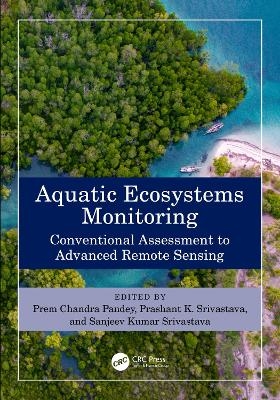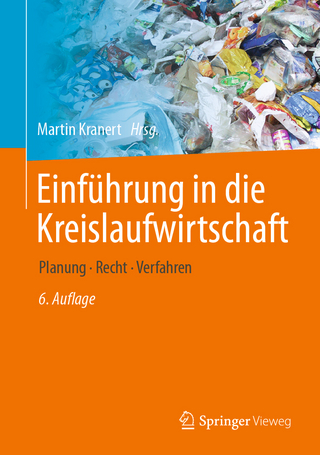
Aquatic Ecosystems Monitoring
CRC Press (Verlag)
978-1-032-39112-0 (ISBN)
- Lieferbar (Termin unbekannt)
- Versandkostenfrei innerhalb Deutschlands
- Auch auf Rechnung
- Verfügbarkeit in der Filiale vor Ort prüfen
- Artikel merken
This book collates traditional and modern applications of remote sensing in aquatic ecosystem monitoring. It covers conventional assessment methods like sampling, surveying, macroinvertebrates, and chlorophyll estimation for aquatic ecosystem health assessment. Advanced remote sensing technology provides timely spectral information for quantitative and qualitative assessment of water quality, shoreline changes, coral bleaching, and vegetation monitoring. The book covers different types of aquatic ecosystems like wetlands, rivers, lakes, saline, and the brackish lake. It also:
Reviews the latest applications of remote sensing in the monitoring and assessment of aquatic ecosystems
Includes traditional methods like cartography, sampling, surveying, phytoplankton assessment, river interlinking, and chlorophyll estimation
Discusses the application of multi-source data and machine learning in monitoring aquatic ecosystems
Discusses aquatic ecosystem management, services, threats, and sustainability
Explores challenges, opportunities, and prospects of future Earth observation applications for aquatic ecosystem monitoring
The book discusses space-borne, airborne, and drone geospatial data. The parts broadly cover aquatic ecosystem monitoring, vegetation management, advanced modeling practices, and challenges. It is meant for scientists, professionals, and policymakers working in environmental sciences, remote sensing, and geology.
About the Editors Dr. Prem Chandra Pandey is an Assistant Professor at the Shiv Nadar Institution of Eminence (Deemed to be University), Greater Noida, India. He was associated with Tel Aviv University as Research Scientist and with Banaras Hindu University as Post-Doctoral Scientist. Dr. Pandey received his Ph.D. degree from the University of Leicester, United Kingdom, under the Commonwealth Scholarship and Fellowship Plan, Association of Commonwealth Universities. Dr. Pandey is the recipient of several international and national awards like Inspire, Malviya Gold medal, DST-SERB, UGC-MHRD, and Tel Aviv University fellowship. He is serving as editorial member for the journals, International (Taylor & Francis), Sustainable Development (IF- 12.5 Wiley), and associated with Remote Sensing (MDPI) as topic editor. He has authored over 60 research articles and edited more than eight books and 25 book chapters. Dr. Prashant K. Srivastava is a faculty at the Institute of Environment & Sustainable Development, Banaras Hindu University. He was previously affiliated with the Hydrological Sciences, NASA Goddard Space Flight Center as a research scientist on SMAP satellite soil moisture retrieval algorithm development, instrumentation, and simulation for various applications. He received his Ph.D. degree from the Department of Civil Engineering, University of Bristol, Bristol, UK. Prashant was the recipient of several awards such as NASA Fellowship, USA; University of Maryland Fellowship, USA; Commonwealth Fellowship, U.K. He has published over 140 research articles, seven books, and over 100 chapters. Dr. Sanjeev Kumar Srivastava is a Senior Lecturer, Geospatial Analysis, University of Sunshine, Australia. He teaches and coordinates spatial science courses which include geographical information systems (GIS) and remote sensing and surveying courses that are part of Geospatial Analysis Minor. He obtained his Ph.D. degree in Geographical Sciences from The Australian National University where he tested several spatial models for predicting fish species’ distribution in the inland aquatic ecosystem. Dr. Srivastava has worked with different organizations including the Australian Defence Force Academy, Bureau of Rural Sciences, The World Fish Centre, National Bureau of Fish Genetic Resources, and several locations at the Australian National University.
Part I: General. 1. Introduction – Editorial Message. Part II: Conventional Aquatic Ecosystems Monitoring. 2. Cartographical Techniques For Wetland Delineation. 2. Freshwater Ecosystem Monitoring: Conventional Assessment of Macroinvertebrates. 3. Evaluating Aquatic Ecosystem Health in the Indian River Linking Program: Diatoms and Macroinvertebrates as Biomonitoring Tools. 4. Multiproxy (Calcareous Nannofossil, Benthic Foraminiferal, and Total Organic Carbon) Records from the Eastern Arabian Sea: Implications for Monsoon-Induced Nutrients and Primary Productivity Changes during the Holocene. Part III: Advanced Aquatic Ecosystems Monitoring. 5.Aquatic Ecosystems Monitoring with Remote Sensing Perspective. 6. Monitoring of Water Quality of Asia’s Largest Brackish Water System, Chilika Lagoon. 7. Stream Channel Dynamics over Alluvial Fan Systems: An Overview. 8. Mapping Shoreline Changes in Two River Deltas of Greece Exploiting Geoinformation Technologies. 9.Application of Remote Sensing for Monitoring Aquatic Vegetation: A Case Study of Egyptian Coastal Wetlands Using MODIS/Terra Data. 10. Monitoring Coastal Chlorophyll-a Concentration in the Coast of North Africa Using Remote Sensing and Machine Learning. 11. Aquatic Vegetation Species Identification and Mapping Using Multisource Data-Review. 12.Investigation of Seasonal Variability of Chlorophyll-a in the Arabian Sea. 13. Management of Aquatic Ecosystems and Aquatic Vegetation for Environmental Sustainability.14. Potential Fishing Zones Estimation along the Coast of India Using Geospatial Technology. 15.Impact of Climate Change and Land Use Land Cover Dynamics on Wetland Ecosystem in Punjab Using Geospatial Technology. 16. Coral Reefs Threat Assessment and Comparative Analysis of Neil and Agatti Island, India, Using Multispectral Approach. 17. Plastic Pollution Is a Serious Menace to Ecosystem Health with Special Reference to Aquatic Ecosystems and Its Associated Challenges, Opportunities, and Mitigations Part VI Challenges and Future Opportunities in Aquatic Ecosystem Monitoring. 18.Challenges and Future Implications in Monitoring and Assessment of Aquatic Ecosystems.
| Erscheinungsdatum | 02.11.2024 |
|---|---|
| Zusatzinfo | 33 Tables, black and white; 104 Line drawings, color; 5 Line drawings, black and white; 27 Halftones, color; 131 Illustrations, color; 5 Illustrations, black and white |
| Verlagsort | London |
| Sprache | englisch |
| Maße | 178 x 254 mm |
| Themenwelt | Naturwissenschaften ► Biologie ► Ökologie / Naturschutz |
| Naturwissenschaften ► Geowissenschaften ► Geografie / Kartografie | |
| Technik ► Umwelttechnik / Biotechnologie | |
| Weitere Fachgebiete ► Land- / Forstwirtschaft / Fischerei | |
| ISBN-10 | 1-032-39112-X / 103239112X |
| ISBN-13 | 978-1-032-39112-0 / 9781032391120 |
| Zustand | Neuware |
| Informationen gemäß Produktsicherheitsverordnung (GPSR) | |
| Haben Sie eine Frage zum Produkt? |
aus dem Bereich


